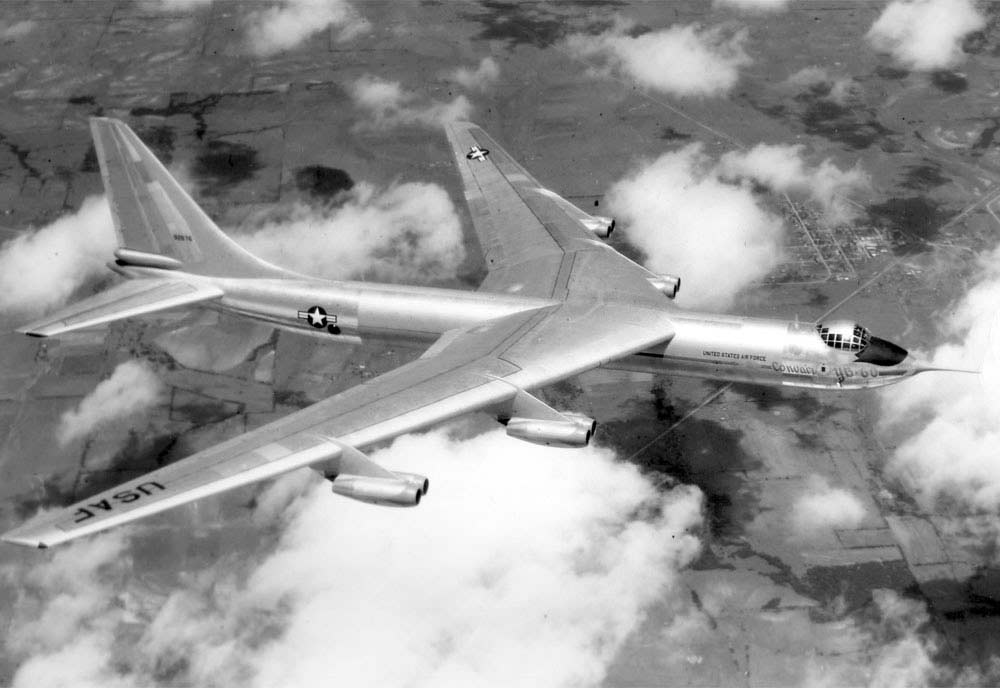The YB-60 was CONVAIR’s swept-wing, jet-powered strategic bomber prototype, an evolution of the B-36 Peacemaker.
In brief
The CONVAIR YB-60 was an experimental bomber aircraft developed as an all-jet derivative of the propeller-driven B-36 Peacemaker. Designed during the early 1950s as a part of America’s strategic bomber program, the YB-60 featured swept wings and jet propulsion to improve performance. Despite its advancements, it competed directly with Boeing’s B-52 Stratofortress, which ultimately proved superior in range, speed, and operational flexibility. The YB-60’s first flight was on April 18, 1952, but only two prototypes were built before the project was canceled in favor of the more advanced B-52, marking the YB-60 as a transitional design in the jet age.
The CONVAIR YB-60 represented a critical juncture in aerial warfare technology, transitioning from propeller-driven behemoths to sleek, jet-powered bombers. It encapsulated the technological ambitions and strategic necessities of the early Cold War era.
History of the Development of the CONVAIR YB-60
The post-World War II era saw a rapid acceleration in aviation technology, driven by the Cold War’s demands for superior airpower. In this context, the United States sought to develop a jet-powered successor to the B-36 Peacemaker to maintain its strategic bombing advantage. The CONVAIR YB-60 project was initiated to fulfill this need, representing an evolutionary design shift from the B-36.
Launched by CONVAIR in the early 1950s, the YB-60 was an attempt to extend the operational life of the B-36 design by incorporating jet engines and swept wings. The aircraft first took to the skies on April 18, 1952, showcasing its potential as a long-range bomber. The development aimed to deliver a bomber capable of delivering nuclear payloads deep into Soviet territory, reflecting the era’s strategic deterrence doctrine.
While the YB-60 did not receive a NATO nickname, its development was a testament to the rapid technological advancements characteristic of the Cold War aviation race. The program’s ultimate cancellation was a result of both its performance shortcomings compared to emerging designs and the shifting priorities in bomber technology.
Design of the CONVAIR YB-60
The CONVAIR YB-60 was a direct evolution of the B-36 bomber, incorporating jet engines and a swept-wing design to improve speed and performance. The aircraft was approximately 171 feet long with a wingspan of 206 feet (about 52 meters long with a 63 meters wingspan), representing a significant size for its time. It was powered by eight turbojet engines, a substantial increase in power compared to its propeller-driven predecessor.
One of the major design advantages of the YB-60 was its increased speed and altitude capabilities, crucial for evading enemy defenses. However, the aircraft also had significant drawbacks, including issues with stability and control due to its large size and heavy weight. Its transitional design, while innovative, was quickly overshadowed by more advanced bomber concepts, particularly the B-52’s superior performance.

Performance of the CONVAIR YB-60
The YB-60’s performance was a marked improvement over propeller-driven bombers but fell short of expectations compared to emerging jet-powered designs. It was capable of reaching a top speed of approximately 508 mph (817 km/h) and could fly at altitudes of up to 44,000 feet (13,411 meters). Its range was around 8,000 miles (12,875 kilometers), making it capable of long-duration flights necessary for strategic bombing missions.
In comparison to its main competitor, the B-52 Stratofortress, the YB-60 was slower, had a lower operational ceiling, and was less flexible in terms of payload and mission adaptability. These performance gaps, coupled with the rapid evolution of jet technology, led to the YB-60’s relegation in favor of the more capable B-52.
Variants of the CONVAIR YB-60
The YB-60 program was short-lived, and only two prototypes were built: the initial YB-60 and a slightly modified second prototype. These variants were primarily focused on testing the feasibility of the swept-wing, jet-powered design and identifying improvements over the B-36. However, the program did not progress beyond these prototypes due to its cancellation in favor of the B-52.
Military Use and Combat of the CONVAIR YB-60
The CONVAIR YB-60 never saw combat or active military service. Its development was strictly within the experimental and testing phase, aimed at exploring the potential for extending the B-36’s operational life through jet power and aerodynamic improvements. As only two prototypes were built, and the project was canceled before mass production, the YB-60 remained a testament to the rapid evolution and fierce competition in Cold War military aviation technology.
The CONVAIR YB-60 stands as a symbol of the transitional period in bomber technology, bridging the gap between the propeller-driven bombers of World War II and the jet-powered strategic bombers that would dominate the Cold War skies. While ultimately overshadowed by the superior B-52 Stratofortress, the YB-60’s development highlights the rapid technological advancements and strategic imperatives of the era. Its story reflects the relentless pursuit of air superiority that defined mid-20th-century military aviation, even as it became a footnote in the broader narrative of aerospace innovation.
Back to the experimental aircraft section.